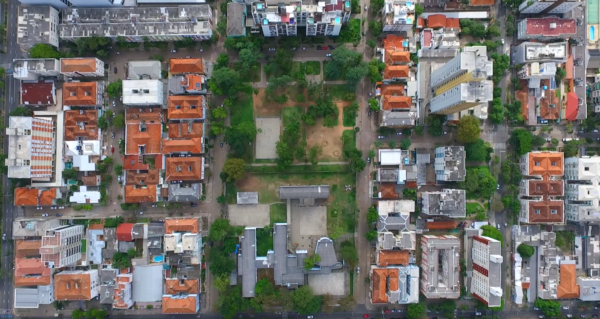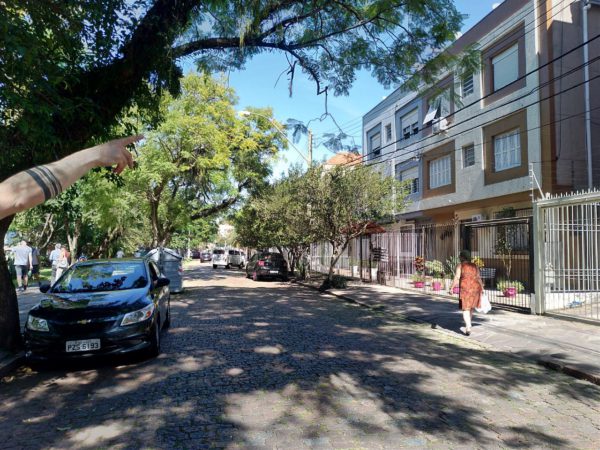Moving towards healthier, more equitable cities in Brazil: the Healthy Urban Mobility (HUM) project
Sabrina da Rosa Machry

The Healthy Urban Mobility (HUM) project is entering its final stage. The research aims to find relevant correlations between urban morphology, modes of transport and its effects in individual and collective health, studying the three Brazilian cities of Brasília, Florianópolis and Porto Alegre, along with Oxford, in the United Kingdom.
A video is now available of the preliminary research, including aerial drone footage of the case study areas to illustrate the urban context and some initial footage of field surveys with participants from the communities engaging in walking and cycling in their neighbourhoods. The focus of the project more generally, and its progress so far, are described in more detail below.
Data collection strategy and community participation
The project started in 2016 and developed a dense quantitative phase throughout 2017. The social survey questionnaire had 375 questions structured in 16 blocks that address individual health conditions, mobility routine and built environment characteristics, combining validated scales such as “NEWS” and the WHO’s Quality Of Life (“WHOQOL”). Two low-income areas – one formal and the other informal – and one middle-income neighbourhood were selected in each city in Brazil. A sample of 1,200 respondents was drawn in each city, evenly divided among the areas.

In order to approach residents and make data collection inside the neighbourhoods possible, the Brazilian team sought to engage with the communities, connecting in particular with their leaders and community and public health personnel. What was remarkable was how much better developed community structure was in low-income areas, mainly through social centres and public kindergartens, while the middle-income area lacks that kind of community organization, reflecting a broader national trend.
This strategy was intended to actively involve communities, making them effective members of the research, not only subjects. The team’s intention was to avoid traditional approaches which maintain a separation between interviewers and interviewees. Residents were recruited to execute the data collection as well as review how the work was progressing, evaluating it and suggesting changes.
Open events were held for disseminating the research activities and incorporating lawmakers, academics and stakeholders, so as to have the desired socially transformative impact.
Preliminary findings of Porto Alegre
Preliminary analysis of the data from Porto Alegre shows that there is a relationship between the mode of transportation choice and the neighbourhood socioeconomic conditions. In middle-income neighbourhoods, there is a significant prevalence of private vehicle usage over public transport (bus), and there are twice as many bicycle trips than those in the low-income areas. Another striking fact is the frequency of walking among residents, with more than two thirds claiming to have made at least one walking trip in the past week.
When it comes to health data, there is again a striking discrepancy between the three different urban environments. Self-reported diabetes and obesity occur at double the rate in poor areas compared to levels in middle-income ones.
The survey findings so far appear to show the relationship between the morphology of urban policies and available transportation services, in addition to the consequences of the residents’ choice of mobility. These preliminary findings seem to confirm the researchers’ initial hypothesis about the existence of a “healthy urban mobility”, attributed to active mobility.
Work in progress

The research teams are currently undertaking the qualitative component of the research, conducting in-depth biographical interviews and “go alongs”. The researchers have been prepared for this through training offered by the Oxford team, who presented the concepts and practical guidance to “mobility methods”.
This approach is being applied to a sample of 30 interviewees per city and is taking place in two separate phases. The first concerns mobility biographies, where people report different milestones of their personal history, identifying the transportation modes they have chosen at different periods of their life. The purpose is to understand the impact of experiences, events and living standards on current mobility choices.
Following this, a “mobile interview” is conducted, in which the interviewer follows a typical daily trip of the interviewee. The “Go-along”, as this method is called, uses cameras and an audio recorder to capture the daily experiences of mobility.
Observing the first qualitative interviews, it is possible to discern that cyclists interviewed for the research associate their choice of cycling with childhood memories. Most of the respondents justify their decison to walk or cycle as a way to pursue a better quality of life. They also report a sense of well-being related to the practice of active mobility.
Looking ahead, a series of academic and social events have been planned to present the research and assess its impact on local conditions. Following this, the goal is to return to the communities in order to discuss these findings. The focus will be on highlighting the health effects of urban transit options such as walking and cycling, while working together to develop strategies that improve active mobility in these neighbourhoods.